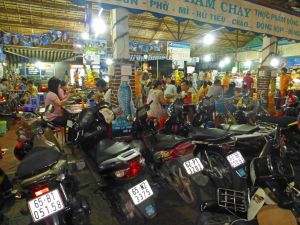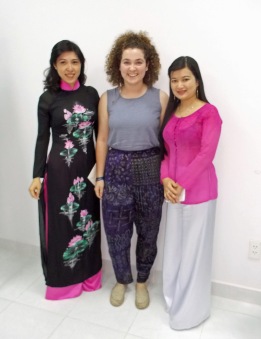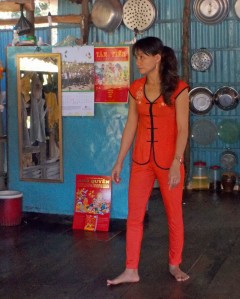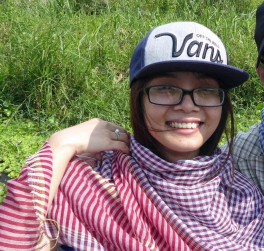Similar in more than one way… by Antonio Morsette
 I am Chippewa-Cree from Rocky Boy, Montana and I am proud of my culture. I want to share with you a short story about mistaken beliefs about people, my misconceptions about Vietnamese people prior to going to Vietnam, and end with some cultural customs and traditions that I believe to be similar amongst our two peoples. I have spoken to many individuals in my time in Vietnam. These people include but are not limited to, my homestay families, college students and professors, and even Buddhist Monks. Though we live thousands of miles apart, we have a lot in common with each other.
I am Chippewa-Cree from Rocky Boy, Montana and I am proud of my culture. I want to share with you a short story about mistaken beliefs about people, my misconceptions about Vietnamese people prior to going to Vietnam, and end with some cultural customs and traditions that I believe to be similar amongst our two peoples. I have spoken to many individuals in my time in Vietnam. These people include but are not limited to, my homestay families, college students and professors, and even Buddhist Monks. Though we live thousands of miles apart, we have a lot in common with each other.
I’ve spoken to many individuals from around the world, including some of the people  I’ve encountered while in Vietnam, and the one thought that is common amongst most of them is, the mistaken belief that Native Americans are stuck in the past. Some of these individuals thought Native Americans still lived in teepees and rode horses all the time. Granted, some of us do own teepees and some of us do ride horses, but that isn’t how we are living today. We live in so called “modern houses” and we even drive “modern cars.” We have all of this, while maintaining our culture, customs, and traditions on and off the reservation, in the face of westernization/colonialization.
I’ve encountered while in Vietnam, and the one thought that is common amongst most of them is, the mistaken belief that Native Americans are stuck in the past. Some of these individuals thought Native Americans still lived in teepees and rode horses all the time. Granted, some of us do own teepees and some of us do ride horses, but that isn’t how we are living today. We live in so called “modern houses” and we even drive “modern cars.” We have all of this, while maintaining our culture, customs, and traditions on and off the reservation, in the face of westernization/colonialization.
 I’m no saint to mistaken beliefs about people, either. Before I arrived in Ho Chi Minh City, Vietnam, I had some biases in my head about Vietnamese people.
I’m no saint to mistaken beliefs about people, either. Before I arrived in Ho Chi Minh City, Vietnam, I had some biases in my head about Vietnamese people. I had pictured everyone working in rice fields and people riding in wagons, being pulled by oxen, everywhere. There are some people that do work in rice fields, from what I have observed, but I haven’t seen many people in wagons being pulled by oxen. This country is filled with “modern” technology and even “modern motor bikes.” They have all of this, while maintaining their culture, customs, and traditions, in the face of westernization, as well.
I had pictured everyone working in rice fields and people riding in wagons, being pulled by oxen, everywhere. There are some people that do work in rice fields, from what I have observed, but I haven’t seen many people in wagons being pulled by oxen. This country is filled with “modern” technology and even “modern motor bikes.” They have all of this, while maintaining their culture, customs, and traditions, in the face of westernization, as well.
 Culture, customs, and traditions are so important to preserve in this day-and-age. They’re important because they bring people together and they help promote a healthier way of life. Vietnamese people, like my Chippewa-Cree people, have been required and forced in some ways, and in other ways voluntarily to integrate some other religions into their own ways of life; two examples of this are
Culture, customs, and traditions are so important to preserve in this day-and-age. They’re important because they bring people together and they help promote a healthier way of life. Vietnamese people, like my Chippewa-Cree people, have been required and forced in some ways, and in other ways voluntarily to integrate some other religions into their own ways of life; two examples of this are  Christianity and Buddhism. However, there are people in both Chippewa-Cree and Vietnamese cultures, who do not practice either of these beliefs. Whether or not any of these peoples practice either of these religions, culture, customs, and traditions from their original cultures, leaks into their everyday lives, and one of the biggest is family.
Christianity and Buddhism. However, there are people in both Chippewa-Cree and Vietnamese cultures, who do not practice either of these beliefs. Whether or not any of these peoples practice either of these religions, culture, customs, and traditions from their original cultures, leaks into their everyday lives, and one of the biggest is family.
 Traditionally, for both Vietnamese people and Chippewa-Cree people, each family has its own rules and values that they are supposed to follow, but the overall themes they are following are very similar amongst the rest of the people. Everyone has a role they must play. The younger generation must show respect to the older generation and
Traditionally, for both Vietnamese people and Chippewa-Cree people, each family has its own rules and values that they are supposed to follow, but the overall themes they are following are very similar amongst the rest of the people. Everyone has a role they must play. The younger generation must show respect to the older generation and  the older generation must tolerate the younger generation. All of this come to pass while the younger generation is learning from the older generation and the older generation is teaching the younger generation how to take care of their bodies and all other parts of creation.
the older generation must tolerate the younger generation. All of this come to pass while the younger generation is learning from the older generation and the older generation is teaching the younger generation how to take care of their bodies and all other parts of creation.
 The younger generation are seen as the newly born to adults, while
The younger generation are seen as the newly born to adults, while  the older generation are the older adults or parents. The older adults, parents, and the newly born are the younger generation to the grandparents and so on and so forth. However the older generation doesn’t stop when people pass on. Respect must be shown to these people as well. In certain cases and when particular ceremonies are happening, the deceased are fed by the living. This is an important aspect in both our cultures. We want to keep our ancestors happy. We don’t want to disrespect them in any way, shape, or form.
the older generation are the older adults or parents. The older adults, parents, and the newly born are the younger generation to the grandparents and so on and so forth. However the older generation doesn’t stop when people pass on. Respect must be shown to these people as well. In certain cases and when particular ceremonies are happening, the deceased are fed by the living. This is an important aspect in both our cultures. We want to keep our ancestors happy. We don’t want to disrespect them in any way, shape, or form.
 To teach the younger generations these essential cultural values, there are traditional stories that are told. These stories are often based around the land, animals, and or super powered beings. There are some animals that are seen as more important others, because they are holy or sacred, but all animals must be respected; the land is seen as a living entity and
To teach the younger generations these essential cultural values, there are traditional stories that are told. These stories are often based around the land, animals, and or super powered beings. There are some animals that are seen as more important others, because they are holy or sacred, but all animals must be respected; the land is seen as a living entity and  must be respected as well; and super powered beings live amongst us, whether we know it or not, and because of this, they must be respected. Ultimately, respect all others and they will show respect to you as well.
must be respected as well; and super powered beings live amongst us, whether we know it or not, and because of this, they must be respected. Ultimately, respect all others and they will show respect to you as well.
Fundamentally, both Vietnamese people and Chippewa-Cree peoples’ cultures are both based around respect and family. This respect is different than economical social status or westernized views of the world, because respect includes the things you cannot see and the things you can. It may be difficult to understand, but it makes sense to the people practicing this way. Whether or not anyone practices other religions or their own traditional beliefs, they know family and respect are above anything else.
The author after a long day in the field.
Sweaty Style – Form and Function of Vietnamese Women’s Fashion by Hannah Fatland
As Vietnam has moved into free market capitalism it has become more connected with the western world, which has strongly influenced fashion trends in the country. In the larger cities that we traveled to like Ho Chi Minh City and Can Tho, many young women wore skinny jeans, crop tops, high waisted short shorts, and designer brands. However the county remains under communist rule and strongly tied to the past and tradition and that continues to be displayed in much of the clothing worn by women such as the traditional áo dài outfits.
Traditional Khmer woven fabric
One thing that strongly influences what a Vietnamese woman wears is the pressure to maintain pale skin. Most of the women dress very modestly, even the young students. For a person with lighter skin is one of wealth and class and a person with a darker skin tone generally is exposed more to the sun from doing hard labor out of doors and a person who does that is low class and poor. Once I discovered this I understood why everyone was so covered up in such hot weather.
Teaching Assistant Duyen covers up from the sun in U Minh Thuong National Park
However not everyone is so modest. In Ho Chi Minh City many teenage and twenty-something girls were not concerned with traditional pressures and were much more in tune with American trends. It was common to see shorts, tank tops, torn jeans, and just more skin in general than anywhere else we went. In Can Tho the girls were still aware of Western trends but they tended to take from the more modest preppy trends of skinny jeans and button up blouses, for coverage and paleness is still important to them. However these outfits are probably the least practical considering the hot and humid climate.
 Young women’s outfits are clearly inspired by what can be found in magazines and what is worn by American celebrities their age. There is
Young women’s outfits are clearly inspired by what can be found in magazines and what is worn by American celebrities their age. There is  also a very strong obsession with designer names like Burberry, Chanel, Ralph Lauren, and Louis Vuitton. They even have facemasks that are knock offs of these brands. In order to prove wealth and class they show off every designer they can. The most popular trends I found were prep, hipster and classic. Prep was worn the most by both genders and across most ages. Hipster inspired outfits can be seen almost exclusively on teens and twenty somethings, while the classic, Chanel style was mostly seen on wealthy middle aged and older women.
also a very strong obsession with designer names like Burberry, Chanel, Ralph Lauren, and Louis Vuitton. They even have facemasks that are knock offs of these brands. In order to prove wealth and class they show off every designer they can. The most popular trends I found were prep, hipster and classic. Prep was worn the most by both genders and across most ages. Hipster inspired outfits can be seen almost exclusively on teens and twenty somethings, while the classic, Chanel style was mostly seen on wealthy middle aged and older women.
 The most formal and traditional women’s wear is the áo dài outfit. It consists of a long, silk tunic that is tight fitting around the bodice and has slits up the sides to the waist and goes over long loose fitting silk pants. It is mostly seen being worn by service women and
The most formal and traditional women’s wear is the áo dài outfit. It consists of a long, silk tunic that is tight fitting around the bodice and has slits up the sides to the waist and goes over long loose fitting silk pants. It is mostly seen being worn by service women and  not by the everyday pedestrian. Many waitresses, hotel desk clerks, and airport service agents wear the áo dài. It is considered formal wear, very flattering for the small waisted petite frames that so many Vietnamese women have. It is also very functional for the hot and humid climate, for it allows for much air flow while being protected by the sun.
not by the everyday pedestrian. Many waitresses, hotel desk clerks, and airport service agents wear the áo dài. It is considered formal wear, very flattering for the small waisted petite frames that so many Vietnamese women have. It is also very functional for the hot and humid climate, for it allows for much air flow while being protected by the sun.
Author Hannah Fatland with two examples of traditional clothing
The less formal version of the áo dài is a silk pajama like outfit. The top and bottoms are generally very simple and made of the same patterned and brightly colored fabric. They are certainly the  most practical of the outfits I saw for the loose fitting silk allows for coolness and comfort and the style still provides protection from the sun. These pajama outfits are sported by women in the cities and rural areas. However few young women wore them and instead stuck to the trendier and westernized wears previously mentioned.
most practical of the outfits I saw for the loose fitting silk allows for coolness and comfort and the style still provides protection from the sun. These pajama outfits are sported by women in the cities and rural areas. However few young women wore them and instead stuck to the trendier and westernized wears previously mentioned.
I was very inspired by the colors, patterns and designs of the more traditional fashions worn by the Vietnamese and I hope that the trend setters do not allow them to fade out completely in their desire to become more developed and westernized. For I found a lot of elegance and beauty in the áo dài, with it’s long lines and flow. Even pajama outfits were exciting in their happy colors and interesting patterns. Though they were very mainstream style, each woman put her own spin on them with a little jacket of contrasting fabric or some crocheted lace around the collar. I think American fashion could certainly benefit from adopting some of the more modest and form-flattering trends that are so popular in Vietnam as well as the bright beautiful patterns.
Traditional Khmer Weaving on a Loom






You must be logged in to post a comment.